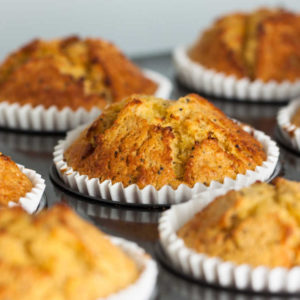
Missing a main baking ingredient that you thought you had in your kitchen? Read on for tips, tricks, and healthy baking substitutions to keep handy!
Getting ready to bake up our favorite sweet treats means pulling out the same usual suspects—flour, butter, sugar, and eggs. But nothing kills a baking buzz like realizing you’re missing one of these essential ingredients! Not to worry, we’ve compiled a list of various substitutions you can use for these main baking ingredients. Oh, and they’re healthier too!
This post contains affiliate links. As an Amazon Associate, we earn from qualifying purchases. The links are noted with an asterisk (*) or Amazon image.
Wondering if there are flour substitutes for baking?
Flour is a main ingredient that contributes to structure. Flour is classified by the way it is processed, which denotes the type. All flours have a different protein content, which is why all-purpose (AP) flour (more protein- denser texture) is used in pie crusts, waffles, and cookies, and why cake flour (less protein- lighter/smoother texture) is primarily good for muffins and quick bread.
- Self-rising flour contains baking powder and has a lower protein content, which makes it perfect for biscuits and recipes that don’t include yeast.
- Whole-wheat flour is a great way to incorporate whole grains and fiber into baked goods, but be cautious when substituting it into recipes. More than a 50% substitution yields a denser end product and can change the texture of the baked good.
- Whole-wheat pastry flour is a great substitution for all-purpose—it’s lighter and has less protein than regular whole-wheat flour and be easily substituted in muffins, quick bread, cookies, and even pie crusts.
- There are also non-wheat flour options, which will add different nutrients and flavors.
Substitution Options for Flour
1 Cup All-Purpose (AP) White Flour:
- ½ cup Whole-Wheat flour + ½ cup AP flour
- ¼ cup Almond Flour and ¾ cup AP Flour
- ¼ cup Oat Flour and ¾ cup AP Flour (to save money, make your own by blending rolled oats!)
- ½ cup Chickpea Flour and ½ cup AP Flour
- 1 Cup Cake Flour:
- 1 cup (minus 2 tablespoons) AP flour
1 Cup Self-Rising Flour:
- 1 cup (minus 2 tablespoons) AP flour + 1 ½ teaspoons baking powder + ½ teaspoon salt
If you’re interested in gluten-free flour substitutions, most grocery stores now offer a variety of gluten-free flour blends (mixtures of products like brown rice flour, tapioca flour, and potato starch). Try subbing this 1:1 with AP flour, or incorporate with almond or gluten-free oat flour for a more desirable texture.
What about substitutes for butter & margarine?
Though one or the other is generally needed to act as a tenderizer and add flavor, which one is better for your health? Let’s look at the facts:
- Butter is an animal-based product, which means that it contains dietary cholesterol as well as saturated fat (SF). One tablespoon of butter contains 7 grams of SF, which is one of the main contributors to high cholesterol levels.
- Butter substitutes or “buttery spreads” come in either a stick form or in a container. They can be used as a replacement for butter in baking recipes to decrease saturated fat or if you are looking to avoid animal-based products. If you can, try looking for products made with sustainable palm oil or without palm to help promote more ethical palm growing and harvesting practices.
- When substituting, keep in mind that each recipe is different. You may want to split the ½ cup of butter called for in the recipe into ¼ cup butter and ¼ cup Earth Balance buttery spread.
Substitution Options for Butter and Oil
1 Cup Butter:
- 1 cup Margarine
- ¾ cup Oil (substitute for melted butter only)
- ½ cup Greek Yogurt and ½ cup Butter
- 1 cup Coconut Oil (this will impart a coconut flavor, so use accordingly)
- 1 cup Avocado (well mashed)
1 Cup Oil:
- 1/2 cup Baby Food Plums, applesauce, blended prunes or mashed banana + ½ cup oil
What about keeping baked goods from sticking to the pan?
We love silicone baking sheets or insulated cookie pans to cut down on parchment paper to save costs and be environmentally friendly. They last forever, are easy to wash and you can lightly coat them with oil for fast and easy cleaning.
Some Sweet Sugar Substitutes for Baking
Sugar is the reason that most of us love baked goods and this tends to draw us to the cookie jar. Sugar is essential to baking, as it provides flavor and acts as a tenderizer. However, sugar can pack a punch, adding 16 calories per teaspoon. That may not sound too bad, but considering most recipes call for a cup (or more!) of sugar, and with 48 teaspoons per cup, you’re looking at an extra 768 calories in the entire recipe! In most recipes, you can cut the sugar by at least ¼ and not even miss it. Even if you’re not concerned about calories, high sugar content displaces nutrients by taking up space in your diet. Incorporating other sources of sweeteners (listed below) can still give you a delicious treat with some added health benefits! In addition, most dessert recipes can use around 1/4 to 1/3 less sugar without compromising taste.
- Honey is not only sweet and flavorful, but it also contains minerals, vitamins, and phytonutrients such as flavonoids and phenolic acids, which act as antioxidants. These compounds can help protect the nervous, respiratory and gastrointestinal systems and also help to protect against risk factors of cardiovascular disease. (1)
- Maple Syrup is will provide a sweet punch with additional beneficial nutrients, including potassium, calcium, magnesium and B vitamins. Like honey, it also has phytochemicals that have antioxidant and anti-inflammatory properties that can help to protect us from various diseases! (2)
- Agave also contains additional nutrients, including thiamine, folate, and vitamin C. (3) Might as well get extra nutrients along with your baked goods!
Substitution Options for Types of Sugar
1 Cup White Sugar:
- 1 cup Sugar Substitute (ex: Splenda. Check the label for exact substitution amounts)
- ¾ cup honey + 3-4 tablespoon reduction of other liquid in recipe OR addition of 3-4 tablespoons flour if there is no other liquid in the recipe
- 1 cup maple syrup + 3-4 tablespoon reduction of other liquid in recipe OR addition of 3-4 tablespoons flour if there is no other liquid in the recipe
- 2/3 cup Agave Nectar + ¼ -1/3 cup reduction of all other liquids
- Replace of the sugar with blended prunes (you may need to reduce liquid by 2 tablespoons)
1 Cup Powdered or Confectioners Sugar:
- 1 cup White Sugar + 1 tablespoon Cornstarch (blend in a food processor to create a powdery texture)
Still, taste too sweet for your liking? Try gradually decreasing the amount of sugar or sugar substitute called for in a recipe by halving the measurement.
Example: For 1.5 cup brown sugar, use ¾ cup brown sugar instead
 Need an egg substitute for baking?
Need an egg substitute for baking?
Although eggs are protein-packed, the yolks also contain cholesterol and saturated fat. While the current dietary recommendations de-emphasize cholesterol as a concern, saturated fat is still linked to chronic disease. Talk to your dietitian or doctor to see how much-saturated fat you should be eating. If egg intake is a concern, egg whites and substitutes are an excellent way to keep the protein high. A bonus- almost all of the egg’s protein can be found in the whites, which functions as a structure builder in the batter and adds moisture to the mixture.
Substitution Options for 1 Whole Egg
- 2 Egg Whites
- ¼ cup Egg Substitute
- 2 Tablespoons Mayonnaise (best in cake batter)
- 2 Tablespoons 2% Greek yogurt
- Reconstituted Powdered Eggs (amount determined on the label)
- 1 Tablespoon Ground Flaxseeds or Ground Chia Seeds, soaked in 3 Tablespoons Water
- ¼ cup Applesauce (look for unsweetened)
- 3 Tablespoons Aquafaba (this is the liquid in canned garbanzo beans– opt for ‘No Salt Added’ beans to reduce added sodium!)
Whether you’ve realized you’re missing one of those key ingredients or you’re just looking for some healthy baking substitutions, these ingredient swaps are great to have on hand. Continue reading more and learn how to get your children involved in the kitchen. Looking for more simple and healthy baking substitutions see Ingredient Substitutions for Milk, Chocolate, and More!












